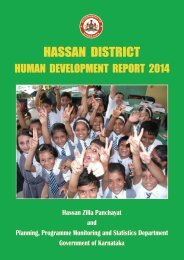Development
Raichur-DHDR-English-2014
Raichur-DHDR-English-2014
Create successful ePaper yourself
Turn your PDF publications into a flip-book with our unique Google optimized e-Paper software.
Raichur District Human <strong>Development</strong> Report 2014<br />
respondents reported to have been<br />
beaten by their husbands.<br />
Hence, early marriage snatches the<br />
girl of her childhood, her right to<br />
get educated and she is often<br />
verbally and physically abused.<br />
More serious is she being forced to<br />
bear children. Since she is not<br />
matured enough to bear the child<br />
not only she risks her health but<br />
also of the child. In fact this is one<br />
of the predominant reasons for a<br />
higher incidence of children born<br />
with low weight, infant and child<br />
mortality as well as maternal<br />
mortality.<br />
Among the respondent women, the<br />
average age at which the first child<br />
was born has been 18.4 years,<br />
which is considered as a risky age<br />
for child birth. It is the highest at<br />
18.8 years among SC-ST sample<br />
and lowest at 18 years among<br />
minority respondents. All the 36<br />
women had children and majority<br />
of them reported they delivered their<br />
first child when they were below the<br />
age of 19 years. The age wise child<br />
bearing shows an interesting<br />
pattern (see Figure 8.6).<br />
The reproductive cycle obviously<br />
starts at too an early age. The data<br />
Figure 8.6: Age at First Delivery (Years)<br />
Source: Field Survey<br />
shows that 83 per cent of<br />
respondents delivered their first<br />
baby before the age of 19 years. The<br />
proportion of women having<br />
children later on declines. Majority<br />
of the women had their first child<br />
when they were 18 years old; about<br />
3 per cent at 16 years of age and<br />
nearly a quarter each at the age of<br />
17 and 19 years. After that, the<br />
child bearing proportion comes<br />
down. This is to be viewed seriously<br />
from the point of view of health of<br />
the mother as well as the child.<br />
Another aspect of women’s health<br />
is how many children she bears on<br />
an average. Greater the number of<br />
children, higher is the risk to her<br />
health. The sample consisted of<br />
women below the age of 30 years<br />
and the data shows that the sample<br />
women had 2.72 children on an<br />
average. This was relatively higher<br />
among minority women (3), SC-ST<br />
households (2.89) compared to<br />
OBC women (2.61). As far as<br />
medical consultation was<br />
concerned three-fourths of the<br />
sample women did consult doctors<br />
for their previous delivery and all<br />
of them accessed the PHC and<br />
government health facility. Across<br />
social groups, while all minority<br />
community women consulted<br />
doctors, only 56 per cent did so<br />
among SC-ST women and 78 per<br />
cent among OBCs. Similarly, 72 per<br />
cent of women accessed advice,<br />
nutritional supplements and<br />
medicines from anganwadi<br />
workers. However, least proportion<br />
of SC-ST women (56 per cent) did<br />
188



